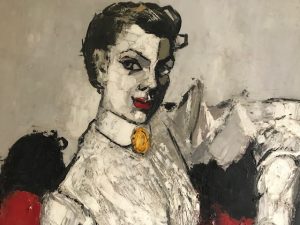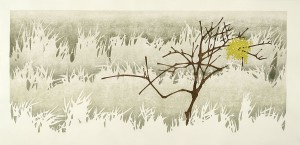I spend a lot of time on social media and on my web site telling people all about what I do and how I do it. I’m quite happy, indeed enthusiastic, in sharing knowledge. I am very pleased to share. My family and non-printmaker friends will tell you how pleased I am. They’d just roll their eyes and look exhausted while doing so.
I’m not alone in this. I have just visited two paint and printing ink manufacturers to interview for the podcast. They are going to be long episodes. Far from wanting to control the podcast around promoting products, both companies revelled in sharing ideas, methods and helpful hints. Both challenged artists to get in touch; ‘the harder the questions the better’.
Sharing techniques and materials has never been a problem for me. Printmaking is very process-led and that means plenty of lovely tools, materials and methods to share. Aside from that, I feel a debt of gratitude to people who helped me along the way. Passing on my knowledge to others is simply keeping the chain of generosity intact as I go from novice to experienced printmaker. I believe generosity in the art world is pretty common, here are a few of my experiences.
I’ll start close to home with my in-laws. My lino tools were given to me to take to art school by my now mother-in-law and former illustrator Sal, whose father James Boswell used them for his own prints and for illustration jobs of all kinds.

They are beautiful professional tools that she entrusted to her son’s 18 year old girlfriend of a year who was about to vanish over the horizon to Aberystwyth University, possibly never to be seen again.
Paul Hogarth, the illustrator, who I met in passing and who took time out to chat and to tell me exactly how hard I would need to work and how much passion was needed to become an artist. It took me many years to realise how sensible and realistic he was and to see how much he didn’t need to waste time with a twenty-something shilly-shallying between a paying job and trying to make it as an artist, but he did so anyway.
Old Mr Lawrence of Lawrence Art Supplies who apparently had all the time in the world to discuss Japanese papers and printing inks in his shop in Bleeding Heart Yard and who treated me like a serious artist when I was anything but.
Ian Phillips, linocut printer and member of Pine Feroda, who told me (when I began printmaking in earnest in 2005) to stop thinking of myself as a woman with a shed and a hobby, to grow up and start behaving like printmaker with a studio and has given me endless helpful advice ever since.
The list goes on, but I am sure you get my point. What goes around comes around and I’m very happy to be a part of that process.
This week on the Ask an Artist Podcast we are celebrating Christmas by discussing the many ways of giving back to other artists, the local community and to our supporters. The podcast is released weekly on Fridays at 10am GMT

